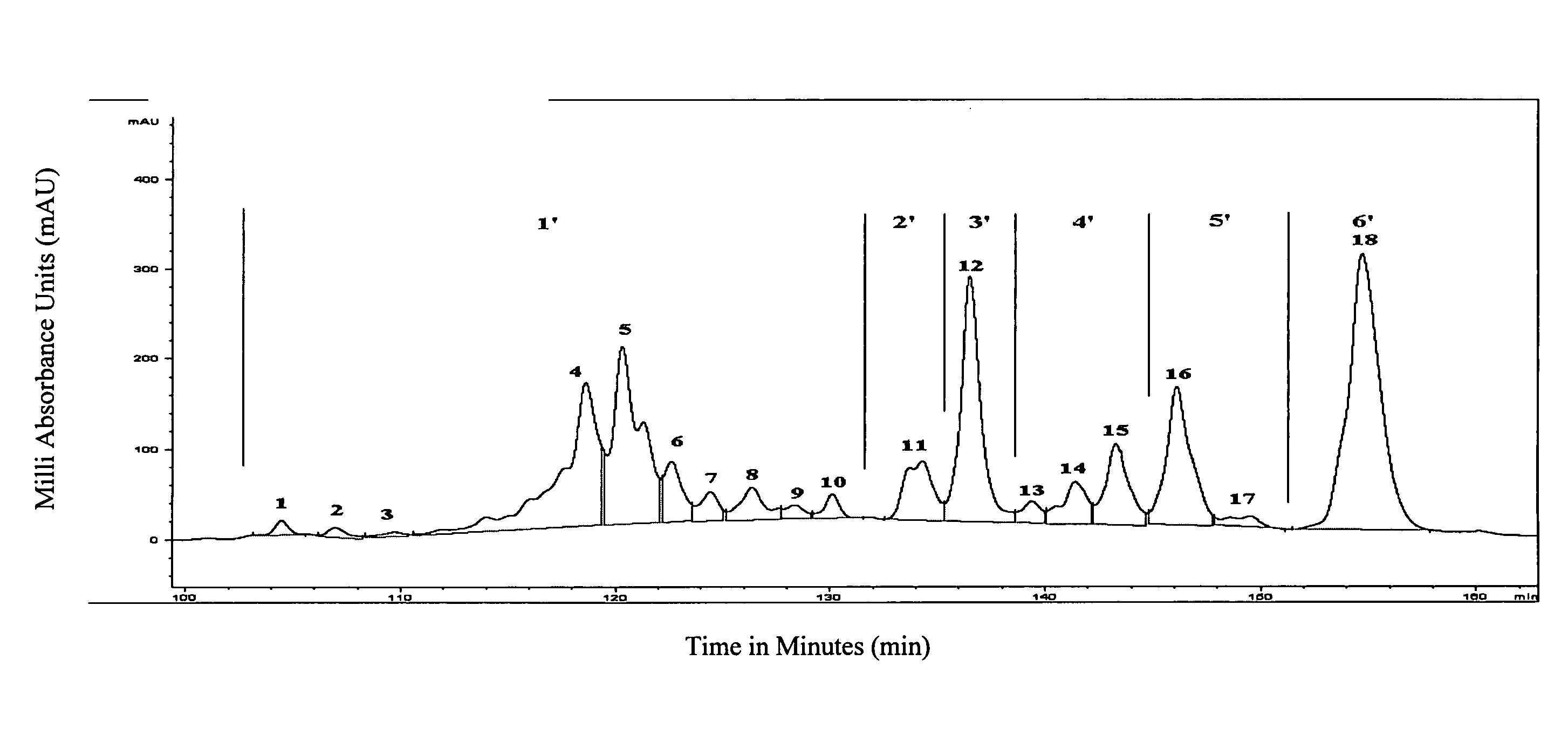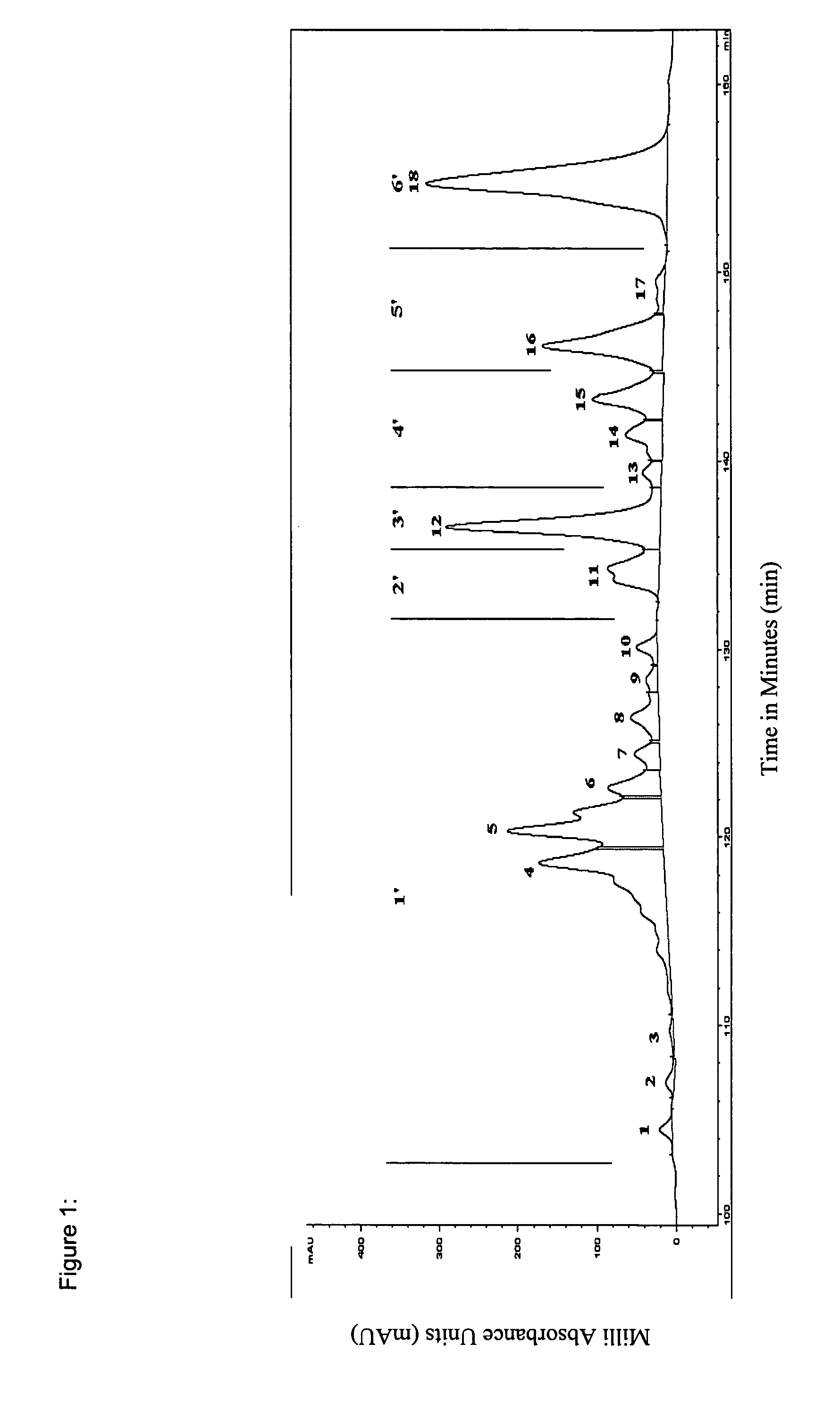Composition comprising mixtures of IFN-alpha subtypes
a technology of interferon and composition, applied in the field of isolating protein composition, can solve the problems of limited biological activity of interferon composition, serious negative effects of interferon composition on patients who must take significant dosages, and the number of side effects, so as to improve the antiviral activity and increase the potency of treatment
- Summary
- Abstract
- Description
- Claims
- Application Information
AI Technical Summary
Benefits of technology
Problems solved by technology
Method used
Image
Examples
example 1
Lymphoblastoid Cell Growth
[0048] A Namalwa-derived (lymphoblastoid) cell line, DB009, is used in this example. Cells are grown in GM-11 medium which is composed of Pro293 (Cambrex, Md., U.S.A.), L-Glutamine, and MAXI-MAb (GTEC, CA, U.S.A.). When a cell count of 1.5×106 to 2.0×106 cells / ml is reached, the cells are diluted in the same medium to a concentration of 5×105 cells / ml.
[0049] When cells are expanded to demand cell density (approximately 3.5−5.0×106 cells / ml), they are treated with a priming reagent and incubated at 37° C. for 24 hours. Then Sendai virus is added and incubated for a further period in lower temperature (approximately 30-36° C.) at titer of 100 HA / 106 cells. The culture medium is separated from the DB009 cells as described below.
example 2
Purification of INF-A
[0050] All purification steps are performed at room temperature unless otherwise specified.
A. Crude Culture Medium Processing
[0051] Approximately 48 hours after Sendai virus induction, DB009 cells are removed by filtrating through 5 μm and 0.22 μm filter and the culture medium is collected. The filtered medium is stored in sterilized containers at 4° C. for further processing.
B. Affinity Purification
[0052] Human IFN-α is purified by affinity chromatography. A monoclonal antibody is coupled to CNBr activated Sepharose-4B and stored at 4° C. Approximately 0.2 mg of crude IFN-α filtrate is loaded per ml of affinity gel (with 2 mg coupled antibody). INF-α amount is determined by ELISA. The column is warmed up to room temperature from 4° C. before use, and is equilibrated with phosphate buffered saline (PBS). After sample loading, the column is washed with 5-column volumes of PBS containing 0.1% Tween 20 (PBST) followed by 20-column volumes of PBS containing 0...
example 3
Separation of IFN-A Subtypes by RP-HPLC
[0056] IFN-α subtypes are separated based on their relative hydrophobicity using RP-HPLC. Separation was achieved using an acetonitrile (ACN) concentration gradient. The RP-HPLC profile of IFN-α is obtained by loading approximately 15-20 μg of purified IFN-α onto an analytical 5 μm / 300 A, 4.6×250 mm “Protein C4” column (GRACEVYDAC™, USA; Cat. No. 214TP54) and shown in FIG. 1. The linear elution gradient used for this C4 RP-HPLC is shown in Table 3 using the automated buffer gradients. Buffer A contains 0.15% trifluroacetic acid (TFA) in 100% H2O (v / v) and Buffer B contains 0.125% TFA in 100% ACN (v / v).
TABLE 3YEAST IFN-A1 COMPARISONTimeFlow rate% A% B00.18 ml / min6040300.18 ml / min60401200.18 ml / min52.547.51300.18 ml / min52.547.51400.18 ml / min51.748.31500.18 ml / min51.748.31620.18 ml / min50.749.31720.18 ml / min50.749.31740.18 ml / min01002240.18 ml / min01002260.18 ml / min60402560.18 ml / min6040
[0057] The purified IFN-α was fractionated into 18 peaks ass...
PUM
| Property | Measurement | Unit |
|---|---|---|
| Mass | aaaaa | aaaaa |
| Atomic weight | aaaaa | aaaaa |
| Molar density | aaaaa | aaaaa |
Abstract
Description
Claims
Application Information
 Login to View More
Login to View More - R&D
- Intellectual Property
- Life Sciences
- Materials
- Tech Scout
- Unparalleled Data Quality
- Higher Quality Content
- 60% Fewer Hallucinations
Browse by: Latest US Patents, China's latest patents, Technical Efficacy Thesaurus, Application Domain, Technology Topic, Popular Technical Reports.
© 2025 PatSnap. All rights reserved.Legal|Privacy policy|Modern Slavery Act Transparency Statement|Sitemap|About US| Contact US: help@patsnap.com



